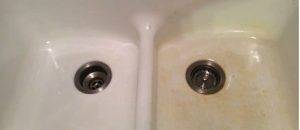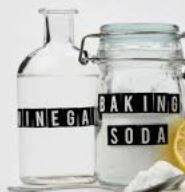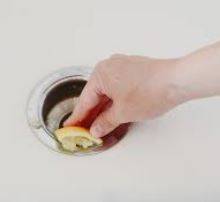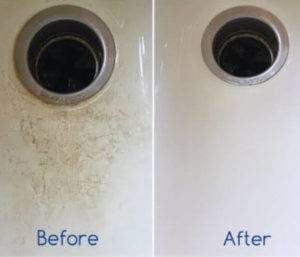How to Get Black Marks Off Porcelain Sink
Are you having trouble clearing hard water stains from your porcelain sink? Well, it is understandable.
Porcelain is a sturdy nonporous material which makes it ideal for sinks. Porcelain also has the advantage of being easy to clean. However, it isn't immune to stains.

You can prevent gunk from building up on the sink surfaces through regular cleaning. Most stains only require a little effort to clean and restore the glaze over the porcelain sink surfaces.
Unfortunately, some stains can be difficult to remove. Hard water stains are a challenge in almost every home.
What are hard water stains?
It is a stubborn white crust, an unpleasant sticky substance that builds up around sinks, showerheads, faucets, and toilets. It has many different names, including hard water stains, mineral build-up, hard water deposits, limescale, and mineral deposits.

Below is an example of hard water stains on a porcelain surface;

Hard water is mineral-rich water. It has a higher than average mineral content, which includes calcium and magnesium. Hard water stains form on your porcelain sink surface over time.
When the hard water evaporates, it leaves mineral deposits. The grimy residue solidifies into the crusty substance or irritating film that is hard to remove.
How to remove hard water stains from a porcelain sink
- Washing with natural cleaners
- Using baking soda and vinegar
- Applying Tartar and vinegar
- Washing with Lemon juice
- Use of Baking soda
- Cleaning with hydrogen peroxide
- Using Tartar and hydrogen peroxide
- Bleach if it is a white porcelain
- Using abrasives to restore the porcelain sink
- Cleaning using a pumice stone
What you need to know first
Hard water stains occur around the faucets, sinks, toilets, and showerheads. The kitchen sink is among the hardest working units in the home. It is exposed to hot water, dish soap, and many cleaning solutions, which only add to the problem.
To restore porcelain sink surfaces, you need the right methods and the right tools. It is essential to be careful when removing the stain to avoid scratching the porcelain.
First things first: Begin by washing the sink
Before you take any measures to remove the stain, clean your tub thoroughly using the ordinary liquid soap. It helps to remove dirt, accumulated soap scum, and other debris. Use a soft sponge to work the detergent into the porcelain.
Make sure you rinse away the soap bubbles. Cleaning the sink makes it easier to see the stain and also prevents the deposits from setting in.
Lets now delve into each in detail
There are several ways to remove hard water stains from a porcelain sink. Let us explore each of them in deeper detail.
1. Washing with natural cleaners
There several natural products, including vinegar, lemon juice, and baking soda, that can help to remove stains on porcelain sinks.
If you want to clean with vinegar;
- Begin by mixing about 25 percent vinegar with 75 percent water in a spray bottle.
- Spray the mixture on the sink surface, especially on the discoloration, and let it sit for at least five minutes.
- Use a sponge or rag to scrub gently.
- When you are done, rinse the sink thoroughly.
2. Using baking soda and vinegar;
You can also use baking soda and vinegar to clean hard water stains. The Arm and Hammer Baking SodaArm and Hammer Baking Soda is one I have used with positive results.

- Make a paste of baking soda and vinegar.
- Apply the resulting paste over the stain
- Wait for 15 minutes to allow the mixture to settle.
- Wipe the area soon as you notice the stain changing color.
- Rinse thoroughly with clean water.
It is crucial to immediately wipe the area dry to prevent water from settling on the cleaned surface.
3. Applying Tartar and vinegar
A mixture of tartar and vinegar may also be active porcelain sinks cleaner. Get Happy Belly Tartar cream and use it following the following steps;
- Mix equal parts cream of tartar and vinegar.
- Apply the cleaner to a sponge or cloth.
- Scrub the sink in small circular motions.
- Give the agent a few minutes to settle and maximize its cleaning power.
- Rinse the sink thoroughly to wash away the residue.
4. Washing with Lemon juice
This is a DIY method that works on loosely formed stains and not stubborn ones.

To use lemon juice to remove hard water stains from your porcelain sink, follow the following steps;
- Spray fresh lemon juice on the stained areas. be sure to include spaces around the faucets.
- Scrub the area clean after 10 minutes.
- Rinse with clean water.
- Wipe the area dry straightway.
If the stain is not removed completely, repeat the process using another piece of lemon. At the same time, you can consider applying another method among the ten discussed in this article
5. The use of Baking soda
Baking soda is a gentle abrasive cleaning agent you can use on porcelain sinks. The agent may also help clear minor scuffing on the porcelain surface. To use baking soda to clean hard water stains;
- Prepare a paste using baking soda and a little warm water.
- Using a soft brush, scrub a mixture over the hard water stain.
- Rinse the area thoroughly.
- Dry the area at once.
6. Cleaning with hydrogen peroxide
Hydrogen peroxide is a gentle cleaning agent that is ideal for use on colored or vintage porcelain.

The steps to apply this method are as follows;
- Cover the sink with paper towels.
- Saturate the towels with peroxide.
- Let the solution sit for at least 30 minutes. It is good to remember that hydrogen peroxide may need more time to remove the stains.
- Carefully remove the paper towels to avoid dripping the solution on other surfaces.
- Clean by using a sponge, old rag, or brush to scrub the cleaner over the surface.
- Rinse out the sink to wash away the remaining hydrogen peroxide.
7. Using Tartar and hydrogen peroxide
This method involves using a mixture of tartar and hydrogen peroxide and cleaning the porcelain sink with it.

Follow the following steps;
- Mix equal parts cream of tartar and hydrogen peroxide.
- You can for instance mix three teaspoonfuls of tartar cream and 3 teaspoonfuls of hydrogen peroxide to form a mixture
- Apply the mixture to a cloth or sponge or cloth.
- Spread the cleaner on the stained areas in small circular motions.
- Allow it to sit for about 10 minutes to maximize its cleaning power.
- Rinse the sink to remove cleaning residue.
IMPORTANT : It is vital to wear safety gear like gloves and goggles to protect your hands, your skin and more importantly, protect your eyes.
8. Use bleach if it is a white porcelain
Sometimes, you can use bleach to remove hard water stains effectively. It is critical to note that this porcelain sink care trick is only safe to use on white porcelain.
REMINDER: Never use chlorine or other acids on a vintage or colored porcelain sink. This is because the acidic cleaning agents can cause damage to porcelain sinks with color and older porcelain.
The best way to ensure a controlled application is to pour the bleach in a spray bottle.

- Line the sink with paper towels.
- Spray the bleach onto the paper towels until they are saturated. It keeps the bleach onto the stains so it can work on them.
- Allow the bleach at least 30 minutes to settle the stains.
- Carefully remove the paper towels to prevent the bleach from dripping on other surfaces.
- Scrub the surface clean with a brush, sponge, or old rag.
- When you are done, rinse out the area with clean water to wash away the remaining bleach.
Make sure to wear eye and hand protection such as goggles and gloves to protect your eyes and skin. It is also essential to remember to use bleach cleaning agents only in a well-ventilated area and take care not to get it on your clothes.
Most noteworthy, don't use bleach cleaners too often because it can dissolve the finish of the porcelain.
9. Using abrasives to restore the porcelain sink;
If you choose this option, make sure you use the gentlest abrasives to minimize the risk of scratching. Read the product labels carefully to ensure they are safe for porcelain surfaces.
It is also advisable to first test out the product look for potential damage.
10. Cleaning using a pumice stone
It is an option to consider only in extreme situations. There is a risk of scratching, and so you must be extremely careful where you can try it. However, a pumice stone can work well with your toilet bowl.
Caution: Avoid harsh cleaning products
Abrasive or rough tools can scratch your porcelain sink. So do not use them to avoid having to reglaze the porcelain sink surfaces. Tools that scratch glass can also scratch the porcelain. You can use this test to help you decide the products to use and those to avoid.
Vintage porcelain sinks are especially susceptible to damage or scratching from harsh chemicals. Also, if you have a colored sink, you need to be careful with cleaning agents. You should not use bleach or anything abrasive.
Conclusion
Among the best ways how to remove hard water stains from a porcelain sink includes using natural cleaners, baking soda and vinegar, tartar and vinegar, and lemon juice.
Other effective methods include using baking soda, hydrogen peroxide, tartar, and hydrogen peroxide, bleach on white porcelain, abrasives, and a pumice stone. All these will work on hard stains including hard water stains that are common at home.
You can read our article on how to remove rust and yellow stains from your tub. If they persist, consider refinishing your porcelain sink as a way of making it look new.
- Author
- Recent Posts

Editor at Home Tuff
As a homeowner, I am specifically keen on home improvement. I am passionate about homes, yards, and home improvement. I blog on home ideas and reviews on solutions that make homes better.

How to Get Black Marks Off Porcelain Sink
Source: https://hometuff.com/sinks/remove-hard-water-stains-porcelain-sink/